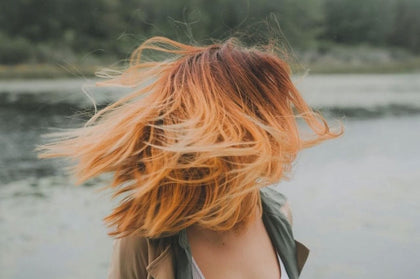Color-treating our hair is more common today than ever. Switching up your natural shade is always fun, but that’s not to say that there aren’t any consequences that come with the process. If you don’t take proper care of your fresh dye job, you can end up with dry, brittle strands quicker than you think. But don’t worry, we’ve got your back! Ahead, we’ve broken down all of the steps you can take to preserve and protect your new hair color, all while saving some time and money.
#include-related-slider#
1. Wash Less
The one step you always want to follow if you color-treat your hair is waiting as long as possible to wash your hair. It’s no secret that constant washing will easily strip your hair of its newly-dyed color. Washing your hair too often can also result in dry, brittle strands. Try to space out at least two days in between your washes to help keep your color vibrant. And most importantly, always use color-safe shampoos and conditioners.
Shop: Lindsay Arnold's Top Vegamour Picks
2. Use a Protective Shampoo
With that being said, when you do wash your hair, be sure to use the right shampoo. There are plenty of color-preserving and protective shampoos available on the market, and many of them specific to each hair color. Blonde hair should be using a purple shampoo to preserve the lighter tones, while brunette hair should use a blue-based shampoo to avoid brassiness. Red hair is one of the tougher hues to preserve in the long-run, but there are also shampoos out there made to prevent your red hair from turning orange before you know it.
Related: Ingredients in Shampoo to Avoid
3. Avoid Hot Showers
The temperature of water that you wash your hair in is just as important as the products you’re using to wash it. As much as we all enjoy hot showers, they’re not worth the damage they can do to color-treated hair. When showering, keep the water at a lukewarm temperature to help maintain your hair’s health. When your showers are too hot, you’re stripping away all of the hard work and effort you put into achieving your new hair color while also weakening your strands.
Find Out: Here's How Often You Should Cut Your Hair
4. And Switch Your Showerhead
Your showerhead can also be a culprit in the case of protecting your hair color. If your water isn’t filtered properly, you risk coming in contact with harmful chemicals and toxins that could be damaging to both your new color and your scalp health. Adding a shower filter can not only help keep your hair color looking fresh, but you’ll notice an improvement in the texture as well. Say goodbye to dull, brittle hair in no time.
Read: 5 Questions to Ask Your Hairstylist
5. Don’t Heat Style Too Often
We understand it’s not always possible to fully stop heat-styling your hair. However, if you’ve color-treated your hair, it’s important to bring it down a notch if it’s something you do often. Dyeing your hair essentially weakens it, and adding heat to that will only cause further damage and potential hair loss. You won’t have to worry about your hair thinning or falling out if you keep the heat-styling to a bare minimum.
Find Out: How Often Can You Dye Your Hair?
6. Add a Gloss
One of the most recommended products for preventing your hair color from fading is a hair gloss. Whenever a fresh dye job is complete, we’re left with shiny, glossy strands but that’s quick to fade. A hair gloss will help rejuvenate that shine and vibrancy that seems to be lost quickly in an instant and help you maintain hair wellness. The great news is that these glossing treatments can be done right at home! It’s a great way to save some money and not have to make another salon trip so quickly.
More From VEGAMOUR
- Shop: Color-Safe Shampoos and Conditioners
- Shea Whitney's Favorite VEGAMOUR Products
- Can Hair Dye Cause Hair Loss?
- How Influencer Madie Wilkes Tackled Postpartum Hair Loss


















